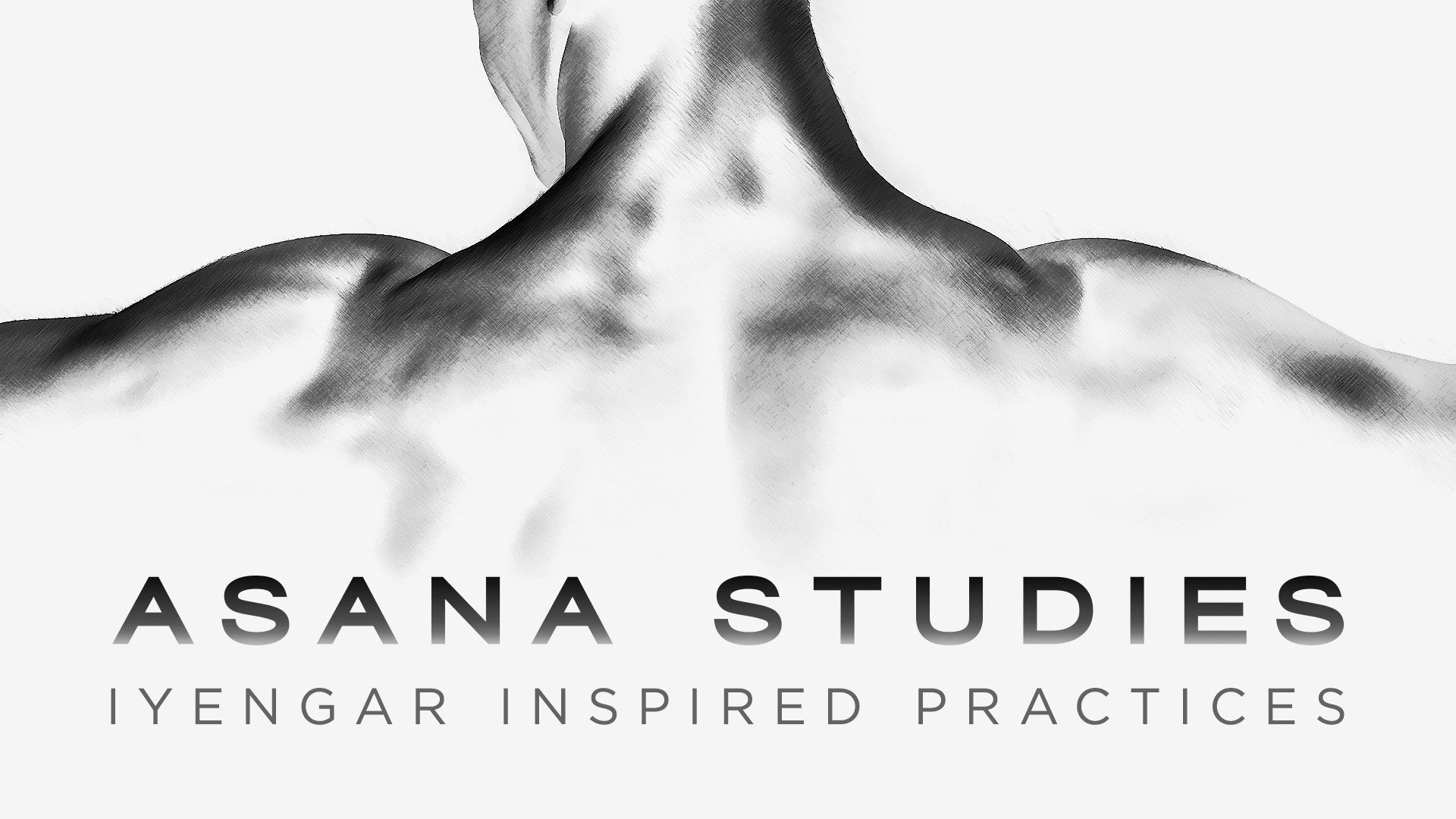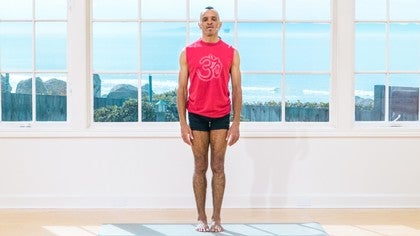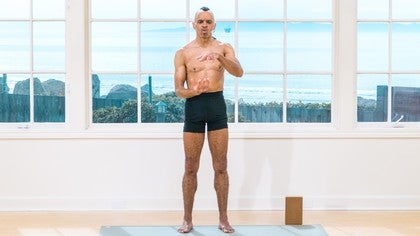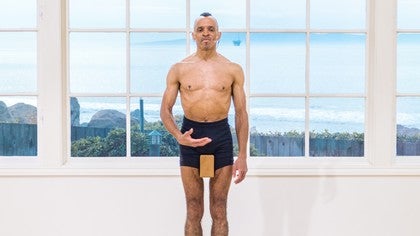Description
About This Video
Transcript
Read Full Transcript
Hello. Today we're going to work on Passive Tadasana. Passive Tadasana is a tune in pose and allows us to walk into the room, arrive, and be where we are, allows us to transition from where we came from to where we are, so it's an opportunity to feel how things at the moment, when we arrive, are, so it's very much like if you were to tune in a radio and you go from one station to another station, and you go and there's static and then you go slowly and you get to the point where you can hear the station arriving and you can start to hear the sound, and then the sound starts to become more clear and then there's that point where you get right with the dial, right at the place where it's most crystal clear and if you go past it, it starts to get a little staticky, more static, and then if you go further it's just static so we want to take the opportunity to go from where we come to where we are, and feel what's going on there, so Passive Tadasana is actually a semi-passive pose. If we're 100% passive, we just fall over. Okay?
The idea, but we call it Passive Tadasana, out of affection because it's just really neat. So the idea, when you do Passive Tadasana is you would look where you're going to start on the mat, or where you're going to step and when you step to place, once you've looked, you look up and don't look as you step to place. When we do Passive Tadasana, we're going to do it with the feet as close together as they can be without them, the feet touching or the knees, whichever happens first with respect to the shape of your legs. So, we'll stand with the feet kind of parallel, and when you think, after a few moments of standing and just gazing straight forward, how the feet are lined up, from feeling, you can look to see if they are indeed the way that you feel that they are. And if they are not, you can line them up and then look up again and feel.
You want to feel the difference if you've changed them, if you walk to place and they felt like they were lined up and you were clear that they were lined up and you saw that you weren't when you looked at them and you realigned them based on what you saw, and you look up, they may feel like they're not aligned but you know indeed that they are because you just looked at them, so you want to begin to reference the feeling after you looked, once you aligned them, so that you can reference that going forward. Even if they feel like they're off because you know they are, you just saw them. Passive Tadasana. So in Passive Tadasana, we start with the eyes looking straight forward. We want to let the bones, the weight be in the heel and the weight is in the heel not so far back in the heel that you feel like you're going to fall back or you have to lift the toes to keep from falling back or press the toes down to keep from falling back, just the way sort of more in the back of the heel.
You want to be there so we can allow the bones to reside and rest over each other, principally over the heel. When we do Passive Tadasana, we keep the sightline forward and eventually, we close the eyelids. Now, with the eyelids closed, we continue to keep the eyes lifted. So, Passive Tadasana is really, technically a semi-passive pose. There's two things that are active in Passive Tadasana.
Just enough energy to keep yourself standing and just enough energy with your eyelids closed to keep your sightline, your eyes, lifted. Now, if you're not sure that your eyes are lifted because oftentimes when we close the eyes we tend to look down, it's quite natural for the eyelids, the vision, the focus to look down when the eyelids close. So it's tricky sometimes to keep the sightline lifted even though the eyelids are closed so if you're not sure if your sightline is lifted, you can slowly open your eyes and see where you're looking and if your eyes are down, you can bring them up, level, and use just enough energy to keep them there as you slowly close your eyelids. Now, in Passive Tadasana, we want to relax the muscles as much as possible. The major muscles as much as possible.
We want to relax the facial muscles, let the tension go out of the neck, the skin at the back of the neck. We want to experience the weight of the shoulders falling towards the floor beside you and the weight of the arms, the arms, allow them to be limp in quality so that their weight, the hands and the arms, hanging off the shoulders allows the shoulders, helps you to feel the shoulders dropping towards the floor. In Passive Tadasana, we want to allow the legs to be straight, keep the legs straight but the, if you can see, the thigh muscles as soft as possible. Want to allow the tension to go out of the buttocks, the lower back and the belly. And indeed also out of the calves, and the feet.
The idea in Passive Tadasana is to allow as much of the muscles and certainly the major muscles, as much of the muscles to relax as possible so that we only use what we need to use to maintain standing, so just enough energy to keep the eyes lifted, sightline forward, as if you're looking into the eyes of someone who's the same height as yourself. Just enough energy to keep yourself standing. So when you do Passive Tadasana, some people really love this, and some people really, really hate it. They find it really disturbing. When you do Passive Tadasana and you get yourself set, you may feel that you're still, very still like a mighty oak tree, or you may feel that you're one of those palm trees that's caught in the tsunami and however your feet may be where they are you may feel like you're wavering all over the place, okay?
The relativity is you may feel steady and stable like a might oak tree and you may actually look to someone looking at you as if you're wandering, your weight is wavering. You may feel like your weight is wavering but you may look to someone who's observing you steady and still like a mighty oak tree. So, how you feel in terms of how the energy's moving through the body with respect to the breath, as you relax, as you let the weight go through the bones and the bones reside and rest over each other, what you feel in terms of the weight shift may not actually be what it actually is. Okay? So, Passive Tadasana, like many of the practices, like many of the practices, takes endurance.
It takes practice. It takes patience. Some of the challenges with Passive Tadasana is learning how to keep the legs straight while the thigh muscles, as you can see, are relaxed, okay? So initially, you may have to use some energy in your thighs to straighten the legs as oftentimes people do. And then slowly learn how to relax them but when you're taking Passive Tadasana, if you relax so much that you let the knees begin to bend, the thigh muscles will contract even still.
With Passive Tadasana, we want to use it as an opportunity to notice what we notice. It's an opportunity to stand and be and experience ourself in our primary orientation as bipeds, standing. Oftentimes, when we're standing, we're going to someplace. We're coming from someplace. We're waiting to go to someplace.
We're standing in line. We're waiting for someone or someone's waiting for us. And it's very rare that we just stand for the sake of standing. To experience ourselves standing. So it's a transition pose, it's a tune in.
It's an opportunity to be present where you are, to arrive, to feel how things are when we're here. You see, because as you approach your practice as you approach the space, you may have an idea of what you think you feel or you may think you may have an idea of what you feel. You may be very clear on what's going on, you may have an intention of what you're going to do or a goal of what you're going to do when you get to the practice. What we want to do when we practice is be with what is and do the practice of the day. So this allows you, Passive Tadasana, once you have the feet set and felt them and once you looked to see that they are the way that you think they are, and you correct them, and then we keep the eyelids closed, eyelids open rather, eyes lifted, and then close the eyes with the eyelids lifted, and begin to relax the muscles, that allows us to tune in.
You want to notice what you notice and you may really enjoy what you experience. You may really not enjoy what you experience. There may be parts of it that you really enjoy and other parts that you find quite distasteful. The idea is to just be with it as it is and accept whether it's pleasant or unpleasant, the experience, and not attach a judgment or a condition to it, or even a response to it. With the breathing in Passive Tadasana, we want to let the body take the breath it needs.
One of the wonderful things about breathing is that breath happens, breathing happens. It's the gift of life, so breathing will continue whether we deem it to continue, whether we're there, paying attention to it to continue, breathing will continue, it happens. So when you do Passive Tadasana, we want to observe and notice the breath in just as we notice the qualities and sensations and the feelings, be they pleasant or unpleasant, you allow your breath to be as it is. There is not a necessity to suck air in using the facial muscles or to blow air out using the torso muscles or to suck air in using the torso muscles or to blow air out using the facial muscles. You allow the breath pathway to be as passive as possible, the sinuses, the palate, your throat, the diaphragm, the muscles of the chest, the torso, allow them to just be as passive and soft and receptive as possible.
'Cause your body will breathe. So what you're tuning into is the wholeness of your presence in your body, allowing your body to breathe and feeling the natural breath that occurs, allowing you to take notice of and experience your frame of mind, your emotional, psychological state, and indeed how we feel in that inner place of our spirit, what is going on there. So part of what we're doing when we practice Passive Tadasana is learning also to self acceptance. Your belly may hang out when you practice Passive Tadasana. You may have a little natural lift in the abdomen.
You may feel things in your body when you let your body stand there in a neutral place that are not particularly to your liking as far as your aesthetic sensibilities. Okay? You just accept that, be with that. So we're tuning in, accepting ourselves, noticing what we notice, being present for that, and allowing the body to unify, to come into union in a moment of standing with the mind, the body becoming with the mind, with the breath, and with the spirit. One other thing.
If you're doing Passive Tadasana and you have pain, then you may have to do an action to support that pain. For instance, if your lower back is bothering you doing Passive Tadasana, you've set yourself, your lower back is bothering you, you may have to actually use your abdominal muscles just a little bit to support your lower back. So that it doesn't hurt you, okay? When you do Passive Tadasana, if you do something to support part of your body to alleviate pain, do just enough of that action to alleviate the pain and don't do it unless you need to do it. When we do Passive Tadasana, we may experience some discomfort.
Don't, try to avoid mistaking discomfort for pain. We want to know the difference. Discomfort comes with working in the body. There's going to be oftentimes some discomfort, okay? So we have to be resilient.
We want to be able to endure a certain amount of discomfort. Pain, however, we don't want to teach ourselves to endure pain. That's not the model of yoga, of hatha yoga, okay? So, if you feel discomfort in Passive Tadasana, try to ride with it. Okay?
If you feel pain you may need to do some action to create a little bit of support, but don't do the action to protect yourself from pain until you've established that there really is indeed pain there. So that's it for Passive Tadasana. Thank you. Namaste.
Asana Studies: Chris Hoskins
Comments
You need to be a subscriber to post a comment.
Please Log In or Create an Account to start your free trial.











